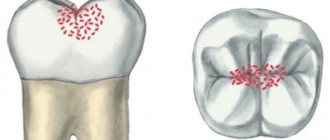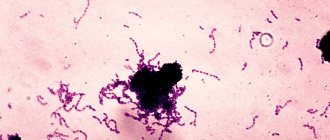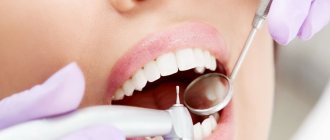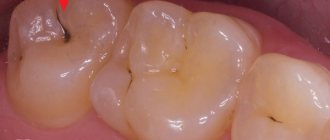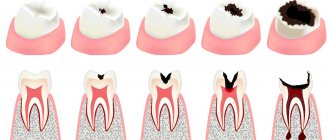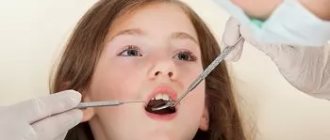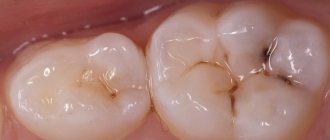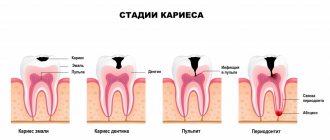In this article
- Early theories of caries development
- Modern approach to the study of caries theories
- Entin's neurotrophic theory
- Martin and Schatz theory
- Charpenak's theory
- Lukomsky's theory
- Entin's physicochemical theory
- Rybakov's concept
- Miller's theory
- Modern scientific theory of caries
- Conclusion
Although modern dentistry treats caries very effectively, scientists have not yet come to a consensus on the origin and causes of the development of this disease. There are different theories about the occurrence of dental caries, and we will talk about the most famous ones in this article.
Early theories of caries development
Scientists of ancient times were interested in why caries occurs, putting forward their own theories. For example, Hippocrates called the cause of the development of caries disease the mixing of bad “juices” of the human body and saw a direct connection between caries and diseases of the gastrointestinal tract and liver.
Scribonius Largus, a physician from Rome, was the author of the theory that dental disease was caused by microscopic worms invisible to the human eye. These worms, according to the Roman doctor, fed on dental tissues, as a result of which carious holes formed in them. As a therapy, he proposed using the steaming seeds of henbane, a poisonous plant from the nightshade family.
The worm theory of tooth decay remained popular for a long time. Initially, it was adhered to by the famous French dentist of the 18th century, Pierre Fauchard, who is considered one of the founders of modern dentistry. But, having examined the teeth under a powerful microscope, he realized that worms did not exist there, which means that the cause of dental caries lies in a different plane. He put forward his own theory, naming two reasons for the development of caries on teeth: diseased blood and lymph, as well as external influences.
Theories of the occurrence of dental caries during antiquity
Dental caries is the most well-known and, despite recent advances in its prevention and treatment in Western Europe and North America, a very common human disease.
The problem of dental caries has been of interest to many researchers and doctors since antiquity. Depending on the state of development of science and medicine, various theories have been proposed, so it is not surprising that quite a few different concepts of caries have been put forward to date.
Thus, even in ancient times (IV century BC), the outstanding Greek physician and philosopher Hippocrates considered the cause of caries to be the “mixing of bad juices” of the body. He associated the occurrence of caries with diseases of the liver, stomach and other internal organs. Around 43 BC e. The Roman physician Scribonius Largus put forward the theory of caries, according to which the cause of its occurrence is very small, invisible to the eye, worms. In his opinion, they eat tooth tissue, resulting in cavities in the teeth. Based on this, as a method of treating caries, he proposed smoking the patient and carious teeth with smoke from henbane seeds. This theory was also popular in the Middle Ages, existing almost until the middle of the 19th century. Its great supporter was Pierre Faucharde, a famous French dentist of the 18th century. However, in a book about the causes of treatment of dental diseases - “Le Chirurgien Dentiste, au Traitede Dentеs” - in 1778, he nevertheless identified two groups of causes of caries: 1) diseased body juices (blood and lymph) or internal diseases; 2) external influences.
Later, the cause of tooth destruction due to caries was considered to be the effect of gastric acids on them, which entered the oral cavity. The first more or less scientific attempt to substantiate the chemical (acid) theory belongs to T. Berdmore (1728), who experimentally demonstrated the dissolution of enamel with inorganic acids (nitric, hydrochloric, sulfuric). Later, other researchers demonstrated the possibility of dissolving enamel also with organic acids. L. Parmlei and E. Parmlei suggested that dental caries occurs due to the action not of those acids that enter the oral cavity with food, but of those that are formed during the decomposition of food debris in the interdental spaces. The further development of medicine and the discovery of the microscope made it possible to put forward a number of new assumptions regarding the occurrence of caries. In 1678, Anton Lewenhoek, the inventor of the microscope, reported at a meeting of the Royal Society in London about his discovery of microorganisms in dental plaque and dentinal tubules during caries. In 1867 Leber and Rotensthein hypothesized that the causative agents of caries are microorganisms like Leptotrix buccalis. They also assumed that these microbes penetrate the dentin of the tooth, softened due to the action of acids. Thus, by the middle of the 19th century, the foundations of the chemical-parasitic theory of caries were laid.
Modern approach to the study of caries theories
Today, all theories of the development of dental caries are usually divided into two large groups:
- Having only historical significance;
- They form the basis for scientifically based therapeutic and preventive measures.
The first group includes Entin’s neurotrophic and physicochemical theory of caries, Lukomsky’s trophic theory, Sharpenak’s metabolic theory and a number of others.
Miller's chemical-parasitic theory of caries was of utmost importance in the development of modern dentistry. Today, the main approaches to the prevention and treatment of teeth are based on Miller’s postulates. Let's take a closer look at the most famous theories of dental caries.
Martin and Schatz theory
According to the authors' conclusions, tooth enamel and dentin consist of mineral and protein components. Initial caries occurs as a result of the destructive action of bacterial enzymes on the protein part of tooth enamel. Further development of carious lesions is accompanied by demineralization of the enamel, which is affected by acid compounds with calcium ions. Since they easily dissolve in water, these compounds are washed out of the tooth enamel, and defects appear on it.
Charpenak's theory
An original study on the causes of dental caries was published in the 40s of the 20th century by Charpenak. In his work, he spoke about the existence of a chemical connection between the human body and the hard tissues of teeth. Therefore, the general condition of the body and how the external environment influences it are directly reflected in the teeth.
According to his theory, at the first stage, carious lesion is a dystrophic process that develops without the participation of bacteria. Its cause is metabolic disorders. And only in the second phase of the development of the disease, microorganisms penetrate into the dental tissues and continue to destroy enamel and dentin.
Trophic (biological) theory of caries according to I. G. Lukomsky
I. G. Lukomsky (1948) based his theory on the principle of recognizing the physiological connection between tooth enamel and the body, which, in his opinion, is realized through odontoblasts. He considered odontoblasts as local and directly acting trophic centers of hard dental tissues - dentin and enamel. Violation of their trophic function is reflected in the metabolism in the hard tissues of teeth, the metabolism in them and leads to the occurrence of caries.
The development of caries occurs as follows. External (exogenous) factors affect the body and disrupt metabolism, especially protein and mineral metabolism. Such factors may be a deficiency of vitamins, minerals (especially fluorine), ultraviolet radiation, etc. The action of external etiological factors leads to endogenous changes, in particular in the central nervous system, which disrupt the trophism of enamel and dentin.
As a result of the action of these factors, odontoblasts become defective (dysfunction). Their function is first weakened (asthenized), and then loses its usefulness (moronic). Functional disorders subsequently lead to physiological transformations: the size and number of odontoblasts decrease, their nuclei and tinctorial properties of cells change. All this leads to metabolic disorders in dentin and enamel. First, dismineralization (discalcification) occurs, and then quantitative changes in the composition of hard dental tissues. Along with decalcification, the composition of the organic protein components of these tissues changes. As a result, destructive phenomena occur in the hard tissues of teeth - the carious process itself (Fig. 46).
The theory of the trophic influence of odontoblasts on tooth enamel was confirmed by I. G. Lukomsky in an experiment. In dogs, the odontoblast layer of the tooth buds and the central fibers of the trigeminal nerve were damaged. As a result, foci of destruction, reminiscent of caries, appeared in the animals’ teeth. Based on this, I.G. Lukomsky concluded that odontoblasts, in addition to dentinogenic, also have a trophic function for the hard tissues of teeth (dentin and enamel). However, from the point of view of the trophic theory, it is difficult to explain the role of microflora and a number of local damaging factors in the occurrence of caries, the mechanism of action of some effective treatments for caries, for example, fluoride compounds. Despite this, an undoubted contribution to the theory of caries is the data of I. G. Lukomsky on the relationship between the pulp and hard tissues of teeth and their influence on the development of dental caries.
Entin's physicochemical theory
Having studied the physicochemical properties of teeth and saliva, Entin decided that dental tissue is a partially permeable membrane that separates two environments - blood and saliva. When the normal pressure of these media on the septum is disrupted (due to an unbalanced diet, a weakened state of the body), problems arise with the nutrition of the enamel. As a result, tooth enamel is attacked by pathogenic microorganisms, contributing to the development of caries.
Risk factors for dental caries
Caries occurs when, as a result of negative factors, the integrity of the tooth tissue is disrupted, after which it becomes susceptible to the action of acids in the oral cavity. Factors influencing the emergence of this process are divided into local and general.
Local factors include:
- Insufficient oral hygiene.
- Bite abnormalities.
- Presence of braces or dentures.
- Diseases of the dental pulp.
- Low degree of enamel mineralization.
- Lack of calcium or fluoride in the body.
- Smoking.
- Plaque deposition.
- Violations of the composition of saliva or its properties.
- Remains of carbohydrate food in the oral cavity.
Common factors include:
- Stress.
- Radiation.
- Poor quality of drinking water.
- Lack of vitamins.
- Unbalanced diet.
- Genetic predisposition to the disease.
- The presence of somatic diseases in a person.
Rybakov's concept
This scientist believed that the cause of dental disease was changes in the pulp - the loose connective tissue that fills the dental cavity. He assumed that the development of carious lesions begins from the inside and spreads from the center to the enamel of the tooth. According to Rybakov’s theory, at different periods of life a person is influenced by various factors that can cause carious tooth decay. In total, the author identified 6 age periods, and in each there were several factors contributing to the development of caries.
The above theories have a rational grain, but at the same time there are many controversial issues that do not fully explain all the nuances of the occurrence of caries. Therefore, it is impossible to create an effective system for the treatment and prevention of dental diseases based on one of them.
Parasitic theory
Even before our era, it was believed that toothache was caused by parasites, but in ancient times people believed that it was worms that destroyed them from the inside. There are many ancient and medieval treatises and journals that described “tooth worms” in detail and also suggested methods of treating them. The most popular of them are the use of henbane seed smoke, pig gastric juice, and concentrated acids.
However, in the 18th century, Leeuwenhoek was able to examine “the smallest animals” in the tissues of a dead (“rotted”) tooth under a microscope. Although scientists were unable to explain how parasites destroy teeth, this discovery became a prerequisite for the emergence of the chemical-infectious theory.
Miller's theory
Miller's chemical-parasitic theory succeeded in becoming the basis for the modern concept of caries treatment. The development of caries, according to Miller, is due to the complex influence of acids and microbes on teeth and occurs in two stages. First, microorganisms ferment carbohydrates, resulting in the formation of organic acids. Under their influence, hard tissues are destroyed and lose minerals. At the second stage, microbial damage to dentin occurs, and the tooth is destroyed even deeper. Along with the local damaging effect of microorganisms, in his work Miller took into account the important role of other factors in the development of caries. Among them are dietary features with a high content of carbohydrates, a lack of minerals, the quality and quantity of saliva, heredity, and social environment.
Although Miller's theory had, along with strengths, weaknesses, and caused a lot of discussion and controversy, it marked the beginning of a whole series of experimental and clinical studies. And many postulates of the modern concept are directly related to Miller’s theory.
Modern scientific theory of caries
Modern scientists (for example, E.V. Borovsky) believe that dental caries occurs due to the negative impact of several groups of factors:
- general (poor quality nutrition, water with low fluoride content, diseases and functional disorders of internal organs);
- local (microflora, deposits on the surface of the teeth, disturbed composition of saliva, residues of carbohydrate foods in the mouth);
- violations of the stability of dental tissues (incorrect chemical composition, hereditary predisposition to caries).
The interaction of different groups of factors creates a situation of increased risk of caries development.
Modern concept of the etiology of caries
Based on historical theories , significant progress has now been made in studying the etiology and pathogenesis of dental caries.
The generally accepted mechanism for the occurrence of caries is the progressive demineralization of hard dental tissues under the influence of organic acids, the formation of which is associated with the activity of microorganisms.
Many etiological factors take part in the occurrence of the carious process, which allows us to consider caries a polyetiological disease.
The main etiological factors are:
· microflora of the oral cavity;
· nature and diet, fluoride content in water;
· quantity and quality of salivation;
general condition of the body;
· extreme effects on the body.
All of the above factors were called cariogenic and divided into general and local, which play an important role in the occurrence of caries.
General factors:
1. Poor diet and drinking water.
2. Somatic diseases, changes in the functional state of organs and systems during the period of formation and maturation of dental tissues.
3. Extreme effects on the body.
4. Heredity, which determines the usefulness of the structure and chemical composition of tooth tissue. Unfavorable genetic code.
Local factors:
1. Dental plaque and dental plaque, replete with microorganisms.
2. Violation of the composition and properties of oral fluid, which is an indicator of the condition of the body as a whole.
3. Carbohydrate sticky food residues in the mouth.
4. Resistance of dental tissues, due to the complete structure and chemical composition of the hard tissues of the tooth.
5. Deviations in the biochemical composition of hard dental tissues and defective structure of dental tissues.
6. Condition of the dental pulp.
7. The state of the dental system during the period of formation, development and eruption of teeth.
Cariogenic factors can be of varying intensity and nature, different options for their interaction contribute to the occurrence of caries, but the leading factor is the microflora of the oral cavity. It is now known that the carious process can develop in the presence of microorganisms in the oral cavity, excess amounts of carbohydrates in food and contact of carbohydrates and microorganisms with tooth enamel. It is well known that carbohydrate intake causes increased acid formation. Thus, taking 10 grams of sugar leads to an increase in lactic acid in saliva by 10-16 times [Leontyev V.K., 1978]. Studies have shown that at a pH more acidic than 6.2, saliva goes from being oversaturated with hydroxyapatite to undersaturated, and therefore turns from a mineralizing liquid to a demineralizing liquid (destroying the hard tissues of teeth). According to modern ideas, the cause of caries is prolonged exposure to acids on dental tissues. The formation of organic acids is associated with long-term enzymatic activity of microorganisms. Long-term exposure to organic acids on tissues is observed with poor oral hygiene, when a dental plaque forms on the enamel; it is under it that an acidic environment is created as a product of the enzymatic activity of a huge number of microorganisms that are capable of ideally absorbing carbohydrates retained in the oral cavity.
Thus, a carious cavity is formed in places of intense acid production, under the dental plaque, where the pH is more acidic 4 - 5. With good washing of the teeth with oral fluid, rare intake of sugar, the local pH shift is quickly leveled out. However, in areas of poor saliva access, with frequent intake of sugar, the demineralization process may prevail over the remineralization process. This means that carbohydrate consumption can be a decisive factor in the shift in pH and disruption of mineralization processes, which leads to the occurrence of caries.
It should be noted that the action of general factors is carried out, as a rule, through the action of local ones. That is, diet, the state of organs and systems, extreme situations can change the composition and properties of oral fluid, affect the microflora of dental plaque and dental plaque.
Sugar has a specific effect on metabolic processes in the oral cavity, causing a “metabolic explosion” after its consumption. This influence of simple carbohydrates is associated with their readiness to enter into metabolism (i.e. metabolism) already in the oral cavity, in contrast to proteins, fats and complex carbohydrates, which require preliminary hydrolysis: swelling and activation. The conditions for the absorption of carbohydrates by the microflora of the oral cavity are close to ideal. Which, naturally, affects the intensity and prevalence of caries.
So, according to modern views, the direct cause of progressive demineralization of hard dental tissues (caries) are organic acids, the formation of which is associated with long-term enzymatic activity of microorganisms. The occurrence of caries is the final stage of the effective interaction of a number of cariogenic factors.
It is known that at a young age the intensity of dental caries damage is higher than at an elderly age. This is due to insufficient mineralization of the tooth enamel immediately after its eruption. The maturation of enamel continues for more than two years, and only complete mineralization causes greater resistance of tooth enamel to the effects of acids, and vice versa, insufficient mineralization creates conditions for rapid demineralization and the occurrence of a carious process. After tooth eruption, the enamel initially matures in the area of the cutting edges and cusps of all teeth, so the carious process occurs precisely in immature fissures and the cervical region, which are risk areas. Today, maturation problems are central to the prevention and treatment of dental caries. Oral fluid plays a huge role in the formation of enamel; the remineralizing ability of the latter has been proven in a number of clinical and experimental studies [Aksamit L.A., 1978; Dubrovina L.A., 1989, Redinova T.L., 1989].
Normally, in the oral cavity, the processes of re- and demineralization are in a state of dynamic equilibrium, however, in the presence of cariogenic factors, a shift in equilibrium towards demineralization is observed.
The state of reduced resistance of dental tissues to cariogenic influences as a result of a violation of the nonspecific resistance of the body due to previous and existing somatic diseases, according to the definition of Professor V.K. Leontyev, is a cariogenic situation.
A cariogenic situation is created when any cariogenic factor or group of them, acting on a tooth, makes it susceptible to the effects of acids. Of course, the trigger is the microflora of the oral cavity, with the obligatory presence of carbohydrates and the contact of these two factors with dental tissues.
In conditions of reduced resistance of dental tissues, the cariogenic situation develops more easily and quickly.
Clinically, a cariogenic situation in the oral cavity is manifested by the following symptoms:
a. poor oral hygiene;
b. abundant plaque and tartar;
c. the presence of multiple chalky carious spots;
d. bleeding gums.
However, even in regions with a high prevalence of caries, there are people who do not have this disease, which made it possible to identify a group of caries-resistant individuals (resistant to caries). At the same time, there are people whose intensity of dental caries damage significantly exceeds the group average level; these were identified as caries-susceptible groups.
Caries resistance and caries susceptibility should be considered in terms of their relationship, just like cariogenic factors (general and local), they can be of varying strength. The occurrence of caries is possible with various options for their interaction. In caries-sensitive teeth, the pathological process occurs faster and more often, which depends on the general condition of the body in the past. Common diseases associated with caries during a given period of time cannot affect the structure and composition of mature teeth, however, disruption of the functional state of organs and systems of the body actively affects the occurrence and course of the carious process, changing the composition and properties of the oral fluid. Factors of resistance and susceptibility to caries are a consequence of certain relationships between the tooth surface and oral fluid. If, during progressive demineralization, cariogenic factors lose their strength or disappear, demineralization may be suspended. The occurrence of caries is determined by many factors, and in the presence of appropriate conditions they become the cause of the disease.
Teeth resistance to caries develops in individuals who are not burdened by previous and chronic concomitant diseases and their consequences, who eat nutritious food and water containing the necessary macro- and microelements, and are not exposed to any harmful influences. Each of the factors listed below depends on the general condition of the body, its reactivity and resistance.
Teeth resistance to caries, or caries resistance, is ensured by:
· chemical composition and structure of enamel and other tooth tissues;
· presence of pellicle;
· optimal chemical composition of saliva and its mineralizing activity;
· sufficient amount of oral fluid;
low level of tooth enamel permeability;
· good chewing load and self-cleaning of the tooth surface;
properties of dental plaque;
· good oral hygiene;
· diet features;
· correct formation of rudiments and development of dental tissues;
· timely and complete maturation of enamel after tooth eruption;
· specific and nonspecific factors for protecting the oral cavity.
The susceptibility of teeth to caries, or caries susceptibility, is promoted by:
· defective enamel maturation;
· a diet with a deficiency of proteins, macro- and microelements, and an excess of carbohydrates;
· water with insufficient fluoride;
absence of pellicle;
· composition of oral fluid, its concentration, viscosity, quantity and flow rate;
· the biochemical composition of the hard tissues of the tooth, which determines the course of caries, since a dense structure with minimal spaces in the crystal lattice slows down the course of caries and vice versa;
· condition of the neurovascular bundle;
· functional state of organs and systems of the body during the formation and maturation of dental tissues;
· abnormal tooth development due to common somatic diseases.
The carious process progresses if the rate of salivation decreases, the amount of saliva decreases, its viscosity increases and, conversely, the carious process slows down or stops at the stain stage with a sufficient amount of saliva and its normal viscosity. A high concentration of macro- and microelements in saliva also stops caries; with a low concentration of mineral elements and a high content of mucin, its progression is observed. Thick, smooth enamel, its dense structure and minimal spaces in the crystal lattice slow down the carious process. Pits, grooves, folds, depressions, thin enamel and loose structure contribute to the rapid progression of the pathological process. In many cases, dental caries occurs in immature fissures, which are risk areas, the latter also including the cervical areas of the teeth. V.K. Leontiev et al. [1984, 1989] in a clinical setting using electrometry showed that the process of enamel maturation is dynamic and depends on the anatomical identity of the tooth, its location, the topography of the tooth area and other factors. Rapid maturation of tooth enamel occurs in the area of the cutting edges and cusps within 4 - 6 months after their eruption. It is especially intense in the first days and weeks after tooth eruption. The enamel of the cutting edges of incisors and fangs matures 2 times faster than in the cervical area. The rate of maturation of the enamel of the fissures of teeth is much slower than that of the cusps and incisal edges, and largely depends on the degree of washing the teeth with saliva and covering the fissures with plaque. An important fact for practice has been established that in all cases, the complete maturation of fissures of premolars and molars varies within a period of up to 2 years. Moreover, in many cases, dental caries occurs in immature fissures and their destruction begins. The main sign of age-related changes in enamel is compaction and a decrease in structure variability due to a decrease in microporosity, which is consistent with the results of studies examining changes in calcium and phosphorus content during enamel maturation. The compaction of enamel is a consequence of the influx of macro- and microelements that change the chemical composition of the enamel, its structure, and properties (an increase in microhardness, a decrease in solubility and permeability occur simultaneously). These facts also explain the fact that at a young age the increase in the intensity of dental caries damage is higher than in the elderly.
V.V. Nedoseko et al. [1987] conducted clinical and laboratory studies to study the resistance of teeth to caries. The level of resistance was determined taking into account the intensity of damage to individual teeth (ITU), groups of teeth and their surfaces. 4 groups of resistance to caries were identified:
1. A high level of resistance was determined in caries-resistant individuals who do not have carious teeth and periodontal diseases. The rate of saliva secretion in such individuals is 2 times higher than in those susceptible to caries. The oral fluid sediment is characterized by low demineralizing activity, the pH of the oral fluid shifts to the alkaline side, the composition is characterized by a fairly high content of total and ionized calcium and a relatively low content of organic phosphate.
2. The average level of dental resistance to caries was detected in individuals whose foci of demineralization were localized on molars, premolars and sometimes canines, caries intensity (ICU) = 9.09 + 0.80 and a low oral hygiene index. The rate of saliva secretion is 2 times lower than in caries-resistant individuals, the pH of saliva is shifted to the alkaline side, it is oversaturated with hydroxyapatite by 16.4% more than the saliva of caries-resistant individuals. Oral fluid is characterized by a high content of inorganic phosphorus and an increased concentration of potassium ions. Saliva contains a large amount of sediment with increased utilization and demineralizing activity. The content of calcium, phosphorus and their ratio in enamel biopsies do not differ from those in caries-resistant individuals. This group is distinguished by the highest rate of remineralization of tooth enamel.
3. A low level of resistance was detected in individuals with caries intensity (CCI) = 17.65 + 1.27. Caries affected all groups of teeth except the lower incisors. The saliva reaction is neutral, it is oversaturated with calcium and phosphates, but the concentration of sodium and potassium is less than the saliva of persons with an average level of resistance. Dental plaque is highly cariogenic, and the hygiene index is low. The rate of enamel remineralization is quite high, but the rate of saliva secretion is 2 times lower than in caries-resistant patients.
4. A very low level of dental resistance to caries was found in individuals with the highest hygiene index and low saliva secretion rate. The oral fluid is undersaturated with hydroxyapatite by 10.3% compared to the saliva of persons resistant to caries. Intensity of the carious process (ICP) = 29.9 + 0.89, all groups of teeth are affected. The rate of enamel remineralization is sharply reduced. The cariogenicity of dental plaque is significantly higher compared to all other groups. The oral fluid contains significantly less total and ionized calcium and phosphates compared to other groups. The utilization and demineralizing activity of saliva is high.
With age, the number of individuals with a high level of resistance decreases among both men and women, mainly individuals with an average and low level of resistance predominate, however, there are significant group differences for each level of resistance in the hygiene index, salivary secretion rate, enamel remineralization rate and etc.
Elimination of the cariogenic situation is associated with remission of a general somatic disease, resumption of oral hygiene, change of place of residence, childbirth and completion of breastfeeding.
All of the above measures lead to the spontaneous disappearance of white carious spots without drug therapy.
The foci of demineralization receive calcium, phosphorus and fluorine from oral fluid, which has pronounced remineralizing activity and can normalize the permeability of enamel, which was increased as a result of exposure to organic acids. In turn, it should be noted that the course of caries in a cariogenic situation is characterized by rapidity, the presence of pigmented decay of dentin, chipping and sharp edges of the enamel. Such a caries clinic in a cariogenic situation is characterized by acute blooming or decompensated caries, that is, high activity of the course.
Article provided by JSC BIOMED
